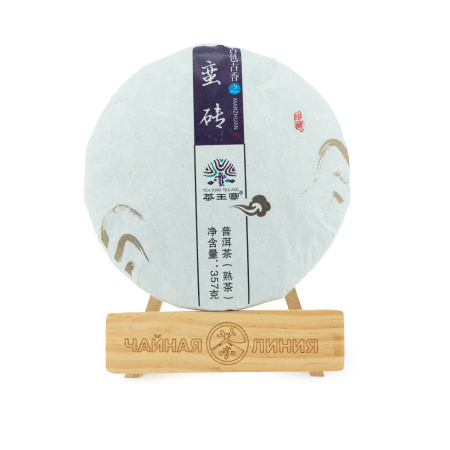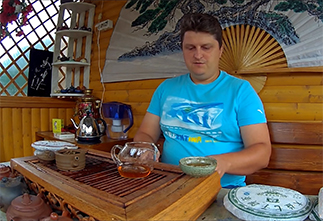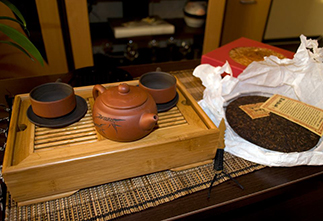-
0 Saturation
-
0 Aftertaste
-
0 Aroma
-
0 Effect
-
0 Balance
-
0 Body
Китайский чай Шу Пуэр 2018 года «Маньчжуань» марки «Чаванчжай» завода «Цзиньдянь»
Шу Пуэр 2018 года «Маньчжуань» (кит. 蛮砖, пиньинь mánzhuān) (Чай с гор Маньчжуань) от марки «Чаванчжай» (茶王寨, chá wáng zhài) завода «Цзиньдянь» (普洱市金典茶叶有限公司, pǔ'ěr shì jīn diǎn cháyè yǒuxiàn gōngsī, «ООО «Чайная компания "Цзинь Дянь" г. Пуэр») — это яркий пример высококачественного пуэра, который сочетает в себе традиции одного из самых известных чайных регионов Китая и современные технологии производства.
О заводе «Цзиньдянь» и марке «Чаванчжай»
Завод «Цзиньдянь» был основан в 2007 году, а его название переводится как «Золотой канон» или «Золотая классика», что подчеркивает стремление компании к производству чая высочайшего качества. Торговая марка «Чаванчжай» (или «Tea King Village») также принадлежит заводу и символизирует преемственность традиций чайного искусства.
Особенности региона Маньчжуань
Маньчжуань — это одна из «Шести великих чайных гор Юньнани» (六大茶山, liùdà cháshān), которые исторически считаются колыбелью пуэра. Этот регион славится своими древними чайными деревьями, благоприятным климатом и уникальными почвами, которые придают чаю неповторимый вкус и аромат.
Характеристики чая
Сырьё и технология производства
Чай «Маньчжуань» 2018 года произведен из сырья «Да е чжун» (大叶种, dàyězhǒng, «крупнолистовой») по технологии «Шайцин маоча» (晒青毛茶, shài qīng máochá). Производство соответствует китайскому национальному стандарту GB/T 22111-2008, который регулирует качество пуэра, включая требования к сырью, этапам обработки и параметрам готового продукта.
Внешний вид
Чайные листья имеют темно-коричневый цвет с золотистыми вкраплениями типсов. Листья равномерно ферментированы, что свидетельствует о высоком качестве обработки.
Аромат
Сухой чай обладает глубоким, насыщенным ароматом с базовыми древесными и сладковатыми нотами. После заваривания аромат раскрывается, добавляя оттенки овощных и варёных нот, что характерно для качественного Шу Пуэра.
Вкус
Вкус чая «Маньчжуань» классический, древесный и ровный. Настой имеет насыщенный темно-коричневый цвет. Во вкусе преобладают теплые ноты древесины, легкой сладости и овощных оттенков. Послевкусие вязкое, напоминающее пастилки от простуды, что добавляет чаю уникальности.
Энергетика и воздействие
Шу Пуэр «Маньчжуань» обладает согревающим эффектом и способствует расслаблению. Этот чай идеально подходит для холодного времени года, а также для тех, кто ценит спокойное и медитативное чаепитие.
Рекомендации по завариванию
Для заваривания Шу Пуэра «Маньчжуань» рекомендуется использовать метод проливов в гайвани или чайнике из исинской глины. Температура воды должна быть около 95–100°C. Первые проливы следует делать короткими (5–10 секунд), чтобы раскрыть аромат и избежать излишней горечи. Постепенно время настаивания можно увеличивать. Чай выдерживает до 8–10 проливов, каждый из которых раскрывает новые грани вкуса.
Шу Пуэр 2018 года «Маньчжуань» от марки «Чаванчжай» завода «Цзиньдянь» — это чай, который сочетает в себе насыщенный вкус, глубокий аромат и богатую энергетику. Его происхождение из региона Маньчжуань и строгое соблюдение стандартов производства делают его настоящим сокровищем для ценителей пуэра. Этот чай подарит незабываемые моменты наслаждения и позволит ощутить связь с древними традициями китайского чайного искусства.
Если вы ищете чай, который сможет удивить своей многогранностью и подарить тепло и уют, Шу Пуэр «Маньчжуань» 2018 года — это прекрасный выбор.
The Jin Dian factory and the Cha Wang Zhai trademark (or Tea King Village) were founded in 2007. The name of the Jin Dian factory translates as “Golden Canon” / “Golden Classic”.
The raw materials are produced in accordance with the GB/T 22111-2008 standard, which is a Chinese national standard that defines the requirements for the production and quality of pu'er, aimed at ensuring the uniformity and quality of pu'er on the market. The GB/T22111-2008 standard includes requirements for tea leaves used to produce pu'er, a description of the processing stages, including drying, fermentation and pressing, parameters that determine the quality of the finished product, including color, aroma and taste, and rules for packaging and label information. The raw materials used are "Da Ye Zhong" (大叶种, dàyězhǒng, "large leaf") using the "Shaiqing Maocha" (晒青毛茶, shài qīng máochá) technology.
Man is an old name for the non-Chinese peoples who lived and still live in the southern regions like Yunnan.
Manzhuang is one of the "Six Great Tea Mountains of Yunnan" (六大茶山, liùdà cháshān). Other mountains that are part of the "Luida Chashan" are Yiban (倚邦, yǐbāng), Manzhi (莽枝, mǎngzhī), Yule (攸乐, yōulè), also known as Jin'o (基诺, jīnuò), Geden (革登, gédēng), Yiwu (易武, yìwǔ).
Shu puer 2017 "Manzhuan" has basic woody and slightly sweet notes in the aroma, then in tea drinking it opens up with some vegetable, boiled. The taste of shu puer "Tea from the Manzhuan Mountains" is classic woody smooth. The aftertaste is viscous, reminiscent of cold lozenges.
|
Name in Chinese
|
蛮砖 |
|
Pinyin
|
manzhuan |
|
English name
|
Tea from the Manzhuan Mountains |
|
Translation
|
Tea from the Manchurian Mountains |
|
Country
|
China |
|
District
|
Pu'er City District |
|
Provinces
|
Yunnan (云南) |
|
Habitat
|
Manzhuan (蛮砖) |
|
Manufacturer
|
Цзинь дянь (金典, jīn diǎn) |
|
Raw material production date
|
2018 |
|
Year of pressing
|
2024 |
|
Pressing form
|
Bing Cha (Cake Tea) |
|
Size
|
20x20x2 |
|
Length, cm
|
20 |
|
Width, cm
|
20 |
- Reviews
- Vkontakte
Pu-erh is one of the most unique types of tea, which only gets better with age. Many people, when they first encounter this tea, wondered: why is pu-erh more often found in pressed form (cakes, bricks, tochas), and not in loose form? The reasons for this are related to both history and the practical aspects of storing and fermenting tea. Despite modern technologies that allow the production of loose pu-erh, the shape of pressed cakes remains unchanged. And pu-erh is more often found on sale in pressed form, for example, in the form of cakes or bricks, and loose pu-erh is less common. We will talk about the reasons for pressing pu-erh into cakes in this article.
Puer is a unique Chinese tea that is distinguished by its depth of taste, complexity of aromas and versatility of aftertaste. Its taste characteristics are formed under the influence of many factors, from growing conditions to the brewing method. Let's look at the main ones.
The question often arises: how to brew puerh correctly? Sometimes the phrase "to get high" is added to it. Moreover, everyone has their own understanding of this phrase. Some mean vigor, and some - intoxication. So how to brew puerh tea correctly? Let's consider several options.
Traveling through the tea mountains, we found ourselves in another land of blue roofs - the village of Zhongcai, which is located in the Menghai district of Yunnan province. According to tradition, we were shown another local tea tree, which, according to the Chinese, is at least a million years old :) The village is very authentic, not designed for tourists, there are many wild pu-erhs there and, of course, we were warmly received. They treated us to local cuisine and tea. We also asked the residents about the prices of tea and how they have changed in recent years.
The tea ceremony occupies a special place in the centuries-old Eastern tradition. And although the essence of this phenomenon remains constant, the nature and external manifestations of the tea ceremony in different nations have their own national characteristics. In each Chinese province, the tea ceremony and the tea used in it are varied: for example, residents of the southern provinces prefer green tea, and residents of the northern provinces - red tea, in Fujian province they more often use Oolong tea, and in Yunnan province Puer tea is widely known.























































































